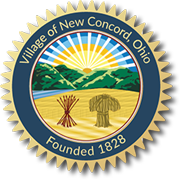Overview
The Village of New Concord, Ohio was laid out on March 24, 1827. The evolution of the village most certainly centered on the establishment of the famous National Road (now known as U.S. Route 40). The village was officially incorporated in 1838. The first church established with the aid of David Findley was known as The United Presbyterian situated on Crooked Creek one mile southwest of the Village. Other churches soon followed with the growth of the community. Currently there are two Presbyterian churches, two Baptist Churches, The New Concord Methodist Church and the New Concord Church of Christ.
No mention of the Village of New Concord would be complete without telling of the founding of Muskingum College in 1837. The first class graduated in 1839 and classes have continued with the mark of progress ever since. In 2003 Muskingum College enrolled over 1,500 students. By 2000, New Concord’s population reached 2,556.
Geographically, New Concord is in east central Ohio, 75 miles east of Columbus, Ohio and 75 miles west of Wheeling, West Virginia. New Concord is located on Interstate 70 and is 8 miles west of Interstate 77 at Cambridge, Ohio, which is 130 miles south of Cleveland. The terrain is gently rolling hills that is predominantly occupied by farms and wooded areas. Many State Parks and outdoor attractions are located nearby.
Muskingum University remains the center of business in New Concord. However, several corporate offices and service companies are now located in the Village. The East Muskingum School District and John Glenn High School, named after New Concord’s most famous native, are located at the north edge of the village. The John and Annie Glenn Historic Site, the William Rainey Harper Cabin and historic “S” Bridge are also located in the Village
The Settling of New Concord, Ohio
The area was settled by Scots-Irish from Western Pennsylvania who spilled off the spines of the Zane’s Trace, the first road into Ohio (1797). People in Ohio led hard lives because it was impossible to get produce to market. Commonly, grain was distilled into whiskey to be transported East on mule back. The National Road was the first great public works in American History. Its goal was to “open wide the gates of the West.” : George Washington. The first dirt was turned at Cumberland, Maryland in 1811. Slowly the road was carved out of the dense forest and mountains of Western Maryland, Pennsylvania, West Virginia and into Ohio in 1825. Red flags placed by surveyors indicated the path of the road. Judge David Findley laid out a new “Piketown” on his pastureland and New Concord was born in 1828.
The road transformed every place it went. Ohio’s population had been 60,000 in 1803; in 1850, it was the third most populace state. Masses of settlers and merchants poured down the road. Once people lived on cornpone and squirrel meat; in 1828, taverns served visitors to New Concord with Chesapeake Bay oysters picked three days before. Many Piketowns contracted when the railroad was built but the road paralleled the National Road in New Concord and the village remained a vital business center until the construction of Interstate 70 in the 1960’s.
Education, Exploration and Transportation
New Concord has been a center of education from 1837, when Muskingum University was founded. William Rainey Harper, the founder of the University of Chicago, was born in Harper’s Cabin, a log house built by the village blacksmith in 1834. His brother, Frank Harper, was a world famous scholar of ancient Assyria. Wm. Oxley Thompson, who transformed Ohio State from an agricultural school into a modern university, was a boarder in the cabin while a student at Muskingum. The University has been a close partner of the East Muskingum School system, located in New Concord.
John Glenn, the first American to orbit the earth, grew up in New Concord. His boyhood home is a Historic Site which features stories of growing up during the Great Depression and the home front during WW II.
Educational opportunities and transportation facilities remain as core attractions for New Concord. In addition to I-70, U.S. Route 40, State Route 83 and the B & O Railroad line, New Concord is just 10 miles from the Zanesville Regional Airport and 75 miles from the Columbus International Airport. Recent improvements in utilities, including a state of the art water system and telephone communications office have made New Concord attractive to a variety of businesses and high tech offices. Although the future is bright for business in New Concord, the small town atmosphere remains the primary attraction to New Concord for students and residents alike.

